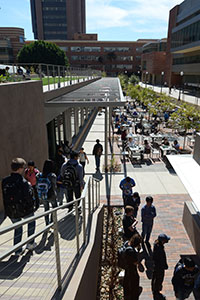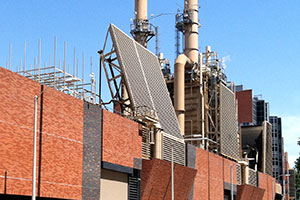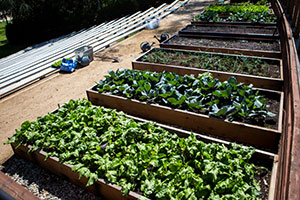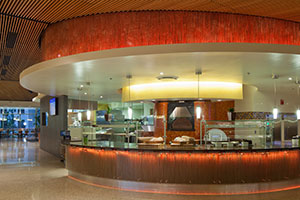 |
|||||||||||||
 |
|||||||||||||
| UCLA experts have predicted that climate change will affect every aspect of the globe: weather, availability of resources, biodiversity and public policy. These pressing issues need sustainable solutions. Through the UCLA Grand Challenge, the university has taken on the mission of moving science to action and leading the way in creating technology, training future leaders and fostering partnerships that will protect Earth’s resources for generations to come. Last September UCLA welcomed the Class of 2020 — by the time they graduate, UCLA will have enacted rigorous environmental sustainability goals:
With a weekday population of around 73,000, UCLA is the same size as a city like Redlands or Redondo Beach, and has an equally large environmental impact. Sustainability means meeting current needs without compromising future generations. Mark Gold ’84, M.A. ’86, D.Env. ’94, associate vice chancellor for environment and sustainability, knows this will require innovation. UCLA leads by example, and this project will be no exception. Gold says, “We’re in the process of initiating the first-ever sustainable UCLA plan. As a campus we have done amazing things, it’s important to bring it all together and look at campus sustainability as a whole.” Take a virtual walk across campus to see what’s being done:
With 60,000 commuters daily, students, faculty and staff are encouraged to use alternatives to driving alone - subsidized bus transit passes, commuter vanpools and discounted parking for carpools. Campus is full of walking paths and bike riders are being encouraged with added bike lanes, bike racks, six bike repair stands and a bike sharing program in the works. UCLA Transportation’s 2016 State of the Commute found 40 percent of commuters drive alone, less than the national average of 73 percent, and a 25 percent drop from a decade ago.
The first stop is the Court of Sciences Student Center. Grab a cup of fair trade coffee and head to the rooftop garden. Designed to blend with the natural environment, this outdoor oasis of drought-tolerant plants creates a green roof that helps maintain the building’s indoor temperature. Materials were recycled or reused—the courtyard is made of reclaimed bricks, the walls use renewable bamboo and tables were reused or made of 100 percent recycled materials. The building received Gold Leadership in Environmental and Energy Design (LEED) certification. LEED-certified buildings may cost more to build, but use less water and energy, reduce greenhouse gas emissions and have lower operational costs. UCLA has also updated energy systems in older buildings, for example installing sensors to turn off lights in empty rooms. In just 10 years, 25 buildings on campus, retrofitted and new, have been LEED certified.
Stop by the Fielding School for Public Health to fill up your reusable water bottle. The water filtration system is a student-initiated project that’s saved more than 26,000 plastic bottles from the landfill. Step inside the stairwell to view the Vertical Art Gallery. This project encourages taking the stairs by transforming a dingy stairwell into a welcoming space. An integral part of sustainability work is bringing campus stakeholders together. Nurit Katz ’08, M.B.A., M.P.P., Chief Sustainability Officer is working towards this goal. She says, “The goal is to make a UCLA a living laboratory for sustainability. A broad cross-section of faculty, researchers, students and staff are coming together to work collaboratively on these pressing issues.” Sustainability advocate Jaime Nack ’98, M.P.P. ’02, president of Three Squares Inc., Founder and CEO of One Drop Interactive and UCLA Alumni Board member, helps organizations improve their environmental footprint with sustainability strategies and climate action plans. She says companies want green venues, alternative transportation options, sustainable materials and to reduce the amount of waste going to landfills. She sees UCLA as the perfect setting to develop innovative solutions, “Corporations use large amounts of resources and have the power to set global trends. Since UCLA is the size of a small city and is very open to trying new technology, it’s a great testing ground."
Walk over to Lot 9, Level 4 - here you’ll find the Smart Grid Living Lab, an electric vehicle (EV) charging station with solar panels and EV chargers connected to the Smart Grid Energy Research Center in Engineering IV. Professor Rajit Gadh is developing an innovative utility grid to charge, and be charged by, EVs. This was one of the first projects to receive a grant from the UCLA Grand Challenge "Sustainable LA -Thriving in a Hotter Los Angeles." Asma Mahdi ’06, Communications & Public Relations manager for Sustainable LA says, “UCLA is one of the first to pioneer something of this magnitude. We are taking what’s happening at UCLA and transforming it to the city of Los Angeles.” Two rounds of projects have already been funded, in 2016 and 2017, with more in the works. The campus-wide research project will assess challenges and look at possible solutions in science, technology and policy to achieve three key goals for Los Angeles County by 2050:
A unique part of the project is the scope: a Five-Year Work Plan assesses the challenge. The project will bring together a cross-section of scholars from across campus, including environmental science, law, economics, urban planning, public policy, engineering, public health, conservation biology, transportation and communication studies. Gold says, “These multi-disciplinary partnerships between faculty working outside usual departments, will make a difference in our community.”
Continue across campus, the brick building behind the police station is the UCLA cogeneration plant. The power plant uses natural gas, instead of coal, to create 80 percent of campus electricity. Chilled water and steam are also produced and distributed through 20 miles of lines and used to heat and cool campus buildings. The plant was state-of-the-art technology when it was built in 1994. A few years ago, University of California President Janet Napolitano announced the Carbon Neutrality Initiative, committing UC to the formidable task of emitting net zero greenhouse gases from its buildings and vehicles by 2025. Gold says, “These goals are bold. We are looking at the big picture of sustainability, and it’s important that it’s all integrated.” A water filtration system was installed at the cogeneration plant in 2016. The system saves 17.3 million gallons of water each year by extending the number of times water, used in the cooling process, can be recycled. UCLA professors Yoram Cohen and Panagiotis Christofides developed an ultra-filtration/reverse-osmosis system able to adapt to changing water quality. This “living laboratory” is another example of how campus is used as a testing ground for new concepts and technologies.
Walk towards Pauley Pavilion, and right across from it is the 7.7 acre intramural field (IM) which installed artificial turf in 2016. Replacing the grass saves 6.4 million gallons of water each year, enough to fill 450 swimming pools. Before installation, research was completed by students from a Sustainability Action Research (SAR) team, a program offered by the Institute of the Environment & Sustainability (IoES). SAR teams investigate, and invest in, sustainability initiatives on campus. For the IM Field this included polling students, comparing similar projects at other universities and researching benefits. Other water conservation projects at UCLA include water recycling, high-efficiency fixtures, capturing rainfall and drought tolerant landscaping.
Pauley Pavilion was certified LEED Gold in 2014, saving water, energy and waste. Katie Zeller ’15 was part of a SAR team that looked at making Pauley zero-waste, leading to the installation of triple-stream trash/recycle/compost bins. She returned to UCLA to serve as sustainability coordinator for UCLA Recreation. Her new challenge is transforming stadium-culture and encouraging fans to utilize the triple-stream bins to separate their trash, especially half-full bottles and cups. Zeller says, “We want to get to a point where it’s integrated into our culture that all events are expected to be green.” The crowd at a recent men’s basketball game generated 1.2 tons of waste, converting Pauley to zero waste will have a large impact.
UCLA gave sustainability pioneer Nack a platform to engage in real world experience as a college student. She sees a powerful benefit to engaging the campus in actions that benefit sustainability. She says, “As an individual you’re able to have impact in different ways. Composting and recycling can be an easy thing to do. If we can reduce the amount of materials going to landfills, we can reduce methane, a powerful greenhouse gas. Individuals can make choices and decisions that have a powerful impact.”
Continue walking up the Hill to Sunset Recreation. At the top you’ll find The UCLA Healthy Campus Initiative and UCLA Recreation living amphitheater where students developed the first large scale edible garden on campus. It will also be an outdoor classroom to teach about sustainable food production, nutrition, health and food concerns facing the planet. Mahdi says, “Sustainability is a broad vision, everything from social justice to smart grid technology. People should have equal access to healthy food and the same clean air. The idea is to take the projects to diverse communities, so they can have the same environmental sustainability."
An integral part of meeting the 2020 goal, and the Sustainable LA plan, will be decreasing overall water use. Katz says, “What’s happening on campus is a model for the city. I’m inspired every day by students, staff, faculty and alumni working to transform the future, getting engaged across many fields to solve these challenges.” Walk back down to Carnesale Commons where professors, staff and students collaborated on an energy use study. Students were given real-time feedback about how much energy they were using to determine how to structure feedback and incentives to reduce energy use.
Another measure used in campus housing is the addition of rooftop solar panels. Solar heated water uses less energy, reduces carbon dioxide emissions and saves money. Energy efficient toilets, faucets and showerheads will also reduce water usage. Current efforts have reduced annual water use by more than 100 million gallons since 2000, bringing the campus about halfway to the 2020 goal.
B-Plate, one of the first health-themed dining halls in the country—a recent menu offered spicy roast beet & carrot salad and a peppercorn crusted portobello stacker. Meals are locally-sourced with seasonal, sustainable, unprocessed and preservative-free food. UCLA Dining Services and Catering are reducing waste by reusing and recycling dining materials and composting waste, diverting more than 50 tons of materials from landfills each month. UCLA continues to lead the way in finding solutions for the climate crisis facing our planet. The work begins on campus, and extends to the County of Los Angeles, and around the globe. Gold says, “The beauty of Los Angeles, a mega-city, is the incredible biodiversity. Anything we do here can have a large impact anywhere in the world. It’s really important from a sustainability viewpoint that we get it right, not just for Los Angeles but beyond. Reaching the goals is an important part of this vital project.” *********** Learn more about "Sustainable LA: Thriving in a Hotter Los Angeles." Learn more about giving to The UCLA Grand Challenge. If you are interested in attending an event for UCLA alumni in sustainability the evening of May 4 at UCLA please email sustainability@ucla.edu for details.
|
|||||||||||||
|
|












